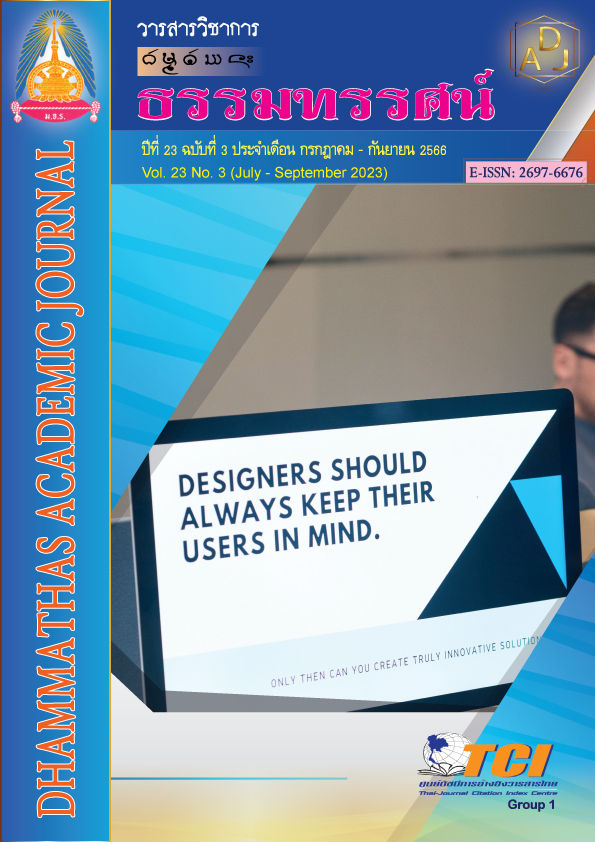ผลกระทบจากโครงการเหมืองแร่หินและอุตสาหกรรมชนิดหินปูน เพื่ออุตสาหกรรมก่อสร้าง กรณีศึกษาพื้นที่ตำบลจรเข้สามพัน อำเภออู่ทอง จังหวัดสุพรรณบุรี
Main Article Content
บทคัดย่อ
การวิจัยครั้งนี้ มีวัตถุประสงค์เพื่อ 1) ศึกษาผลกระทบของโครงการอุตสาหกรรมเหมืองหินและหินปูนสำหรับอุตสาหกรรมก่อสร้างในด้านเศรษฐกิจ สังคม และสิ่งแวดล้อม 2) ศึกษาปัจจัยที่มีผลกระทบต่อทรัพยากรธรรมชาติและสิ่งแวดล้อม และ 3) ประเมินผลการดำเนินงานโครงการเหมืองหิน และอุตสาหกรรมหินปูนที่เข้าหลักเกณฑ์ตามพระราชบัญญัติและประกาศของรัฐบาล เป็นการวิจัยเชิงคุณภาพ ใช้แบบสัมภาษณ์เชิงลึก จากผู้ให้ข้อมูลสำคัญ 3 กลุ่ม ประกอบด้วย กลุ่มที่ 1 ผู้บริหาร หรือผู้แทน ของหน่วยงานส่วนกลาง 5 หน่วยงาน 5 ท่าน กลุ่มที่ 2 ผู้บริหาร หรือผู้แทนโครงการเหมืองแร่หินและอุตสาหกรรมชนิดหินปูนเพื่ออุตสาหกรรมก่อสร้าง 5 หน่วยงาน 5 ท่าน และกลุ่มที่ 3 ผู้มีส่วนได้ส่วนเสียโครงการเหมืองแร่หินและอุตสาหกรรมชนิดหินปูนเพื่ออุตสาหกรรมก่อสร้าง จำนวน 5 กลุ่ม จำนวน 15 ท่าน รวมผู้ให้ข้อมูลสำคัญทั้งหมด 25 ท่าน วิเคราะห์ข้อมูลโดยการตีความและอ้างอิงทฤษฎีที่เกี่ยวข้อง
ผลการวิจัยพบว่า
1. โครงการนี้มีความสำคัญต่อภาคเศรษฐกิจ สร้างรายได้และการเจริญเติบโตทางเศรษฐกิจภายในประเทศ มีการจ้างแรงงานในท้องถิ่น ส่วนด้านสิ่งแวดล้อม ส่งผลต่อมลพิษทางอากาศ และแรงสั่นสะเทือนต่ออาคารและโบราณสถานสำคัญของเมืองโบราณอู่ทอง จังหวัดสุพรรณบุรี
2. ผลกระทบต่อทรัพยากรธรรมชาติ สิ่งแวดล้อม เนื่องจากโรงโม่หินอยู่ใกล้กับวนอุทยานพุม่วง อำเภออู่ทอง จังหวัดสุพรรณบุรี ซึ่งมีผลต่อการท่องเที่ยวที่มาเยี่ยมชมธรรมชาติ ประกอบกับการดำเนินการโครงการนี้ส่งผลต่อทรัพยากรดิน ทำให้ไม่เหมาะแก่การทำการเกษตร และส่งผลกระทบไปถึงปศุสัตว์ของเกษตรกรในพื้นที่ต้องกินหญ้าที่ปนเปื้อนฝุ่นเป็นอาหาร รวมทั้งการดำรงชีวิตของชุมชน
3. การดำเนินโครงการนี้ ไม่ได้เป็นไปตามหลักเกณฑ์ EIA หรือจัดทำแต่เพียงรูปแบบเพื่อให้ผ่านเกณฑ์ตามที่กฎหมายกำหนด และประกาศของทางราชการเท่านั้น
Article Details

อนุญาตภายใต้เงื่อนไข Creative Commons Attribution-NonCommercial-NoDerivatives 4.0 International License.
เพื่อให้เป็นไปตามกฎหมายลิขสิทธิ์ ผู้นิพนธ์ทุกท่านต้องลงลายมือชื่อในแบบฟอร์มใบมอบลิขสิทธิ์บทความ ให้แก่วารสารฯ พร้อมกับบทความต้นฉบับที่ได้แก้ไขครั้งสุดท้าย นอกจากนี้ ผู้นิพนธ์ทุกท่านต้องยืนยันว่าบทความ ต้นฉบับที่ส่งมาตีพิมพ์นั้น ได้ส่งมาตีพิมพ์เฉพาะในวารสาร วิชาการธรรม ทรรศน์ เพียงแห่งเดียวเท่านั้น หากมีการใช้ ภาพหรือตารางของผู้นิพนธ์อื่นที่ปรากฏในสิ่งตีพิมพ์อื่นมาแล้ว ผู้นิพนธ์ต้องขออนุญาตเจ้าของลิขสิทธิ์ก่อน พร้อมทั้ง แสดงหนังสือที่ได้รับการยินยอมต่อบรรณาธิการ ก่อนที่บทความจะได้รับการตีพิมพ์เอกสารอ้างอิง
ชาย โพธิสิตา. (2550). ศาสตร์ และศิลป์แห่งการวิจัยเชิงคุณภาพ. (พิมพ์ครั้งที่ 3). กรุงเทพฯ: อมรินทร์ พริ้นติ้งแอนด์พับลิชชิ่ง.
ชินพรรธน์ ธนพงษ์วัฒน์. (2563). ปัญหาและอุปสรรคทางกฎหมายเกี่ยวกับการบังคับใช้พระราชบัญญัติแร่ พ.ศ. 2560. วารสารวิจัยมหาวิทยาลัยเวสเทิร์น มนุษยศาสตร์และสังคมศาสตร์, 6(2), 49-58.
ปริญญารัตน์ เลียงเจริญ. (2559). เหมืองแร่กับการจัดการผลกระทบสิ่งแวดล้อมและสุขภาพ. เข้าถึงได้จาก https://prachatai.com/journal/2016/06/66239
รัตนา คัมภิรานนท์, สรินธา สุภาภรณ์ และนิดาพร ศุขเขษม. (2554). การรับรู้การเปลี่ยนแปลงสภาพแวดล้อม และผลกระทบต่อภาวะสุขภาพของประชาชนที่อาศัยในพื้นที่การทำเหมืองแร่หินอุตสาหกรรม ตำบลห้วยกะปิ อำเภอเมือง จังหวัดชลบุรี. วารสารสาธารณสุขศาสตร์, 41(3), 39-49.
รัตนาภรณ์ เพ็ชรประพันธ์, วันดี ไข่มุกด์ และฐิติวร ชูสง. (2558). การประเมินระดับเสียงและสมรรถภาพ การได้ยินของพนักงานโรงงานโม่หินแห่งหนึ่ง ในจังหวัดนครศรีธรรมราช. วารสารความปลอดภัยและสุขภาพ, 8(27), 12-25.
สำนักงานนโยบายและแผนทรัพยากรธรรมชาติและสิ่งแวดล้อม. (2564). แผนจัดการคุณภาพสิ่งแวดล้อม พ.ศ. 2565. เข้าถึงได้จาก http://www.oic.go.th/FILEWEB/CABINFOCENTER38/DRAWER027/GENERAL/DATA0001/00001415.PDF
อภินันท์ จันตะนี. (2565). ระเบียบวิจัยทางสังคมศาสตร์. กรุงเทพฯ: จรัลสนิทวงศ์การพิมพ์.
Klaus, S. (2018). The Fourth Industrial Revolution Kanwariya Me Phaiboon, translated. (3rd ed). Bangkok: Amarin How to Amarin Printing and Publishing.
Stern, D. I. (2003). Environmental Kuznets curve. Retrieved From http://www.sterndavidi.com/Publications/EKC.pdf

